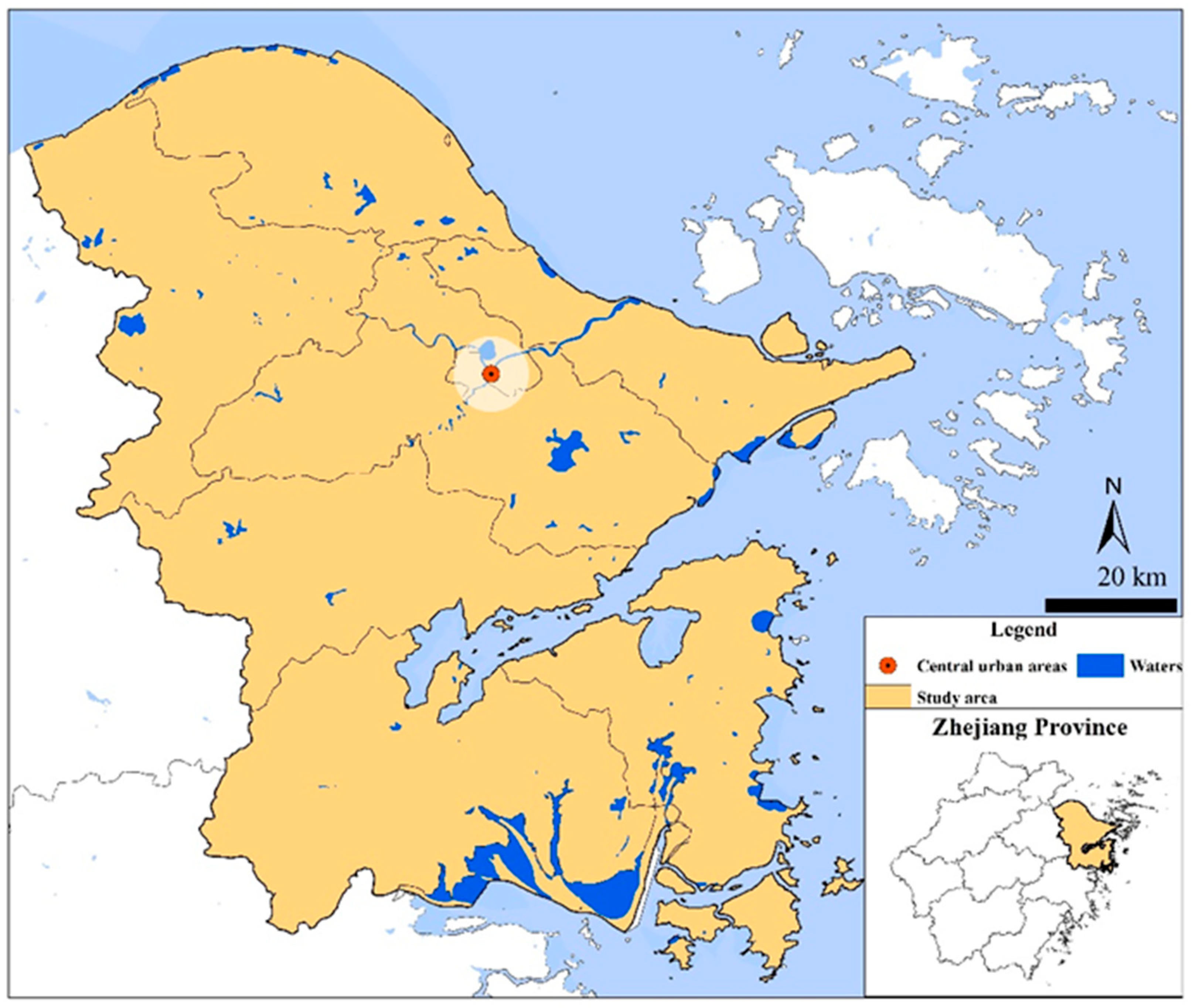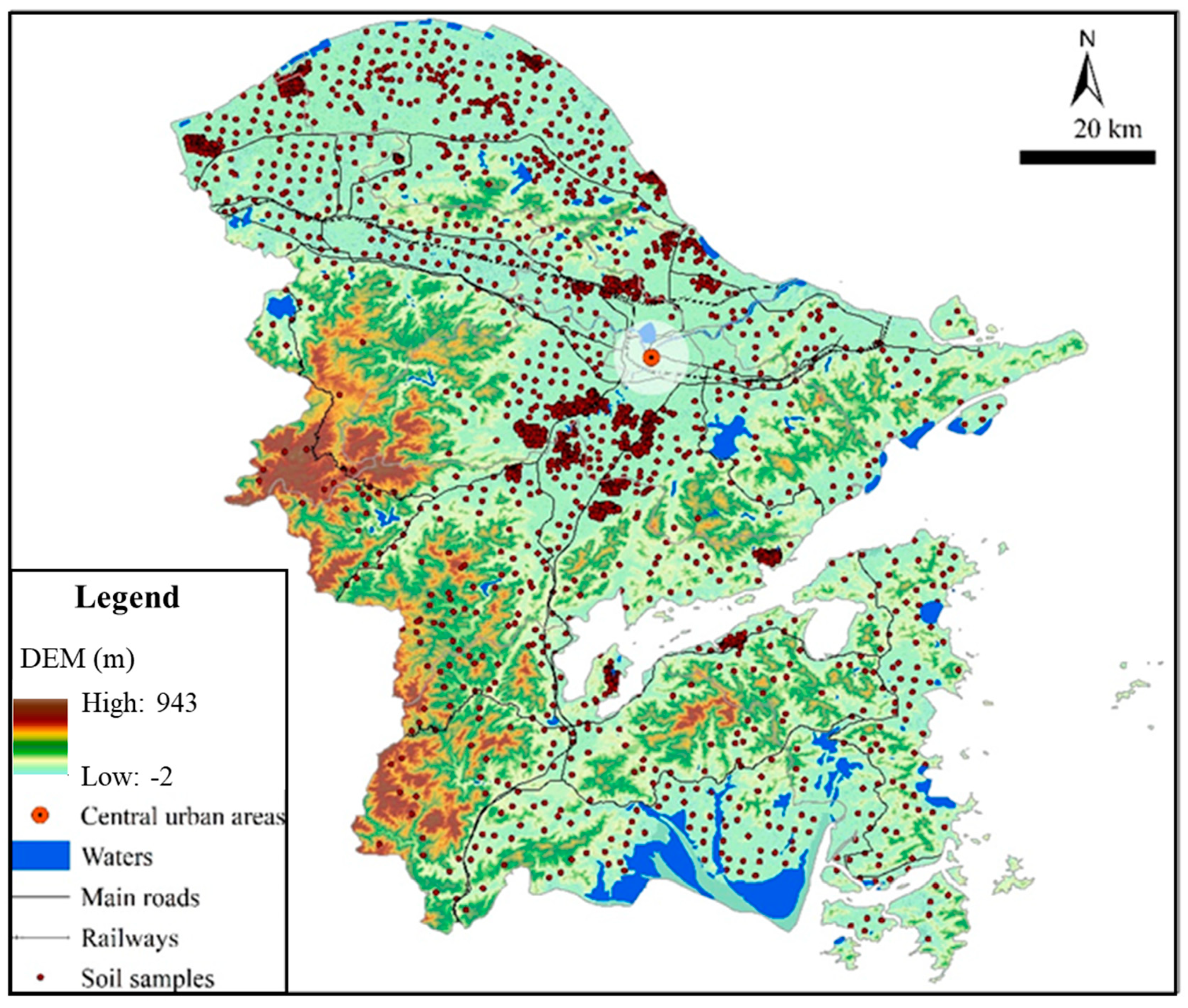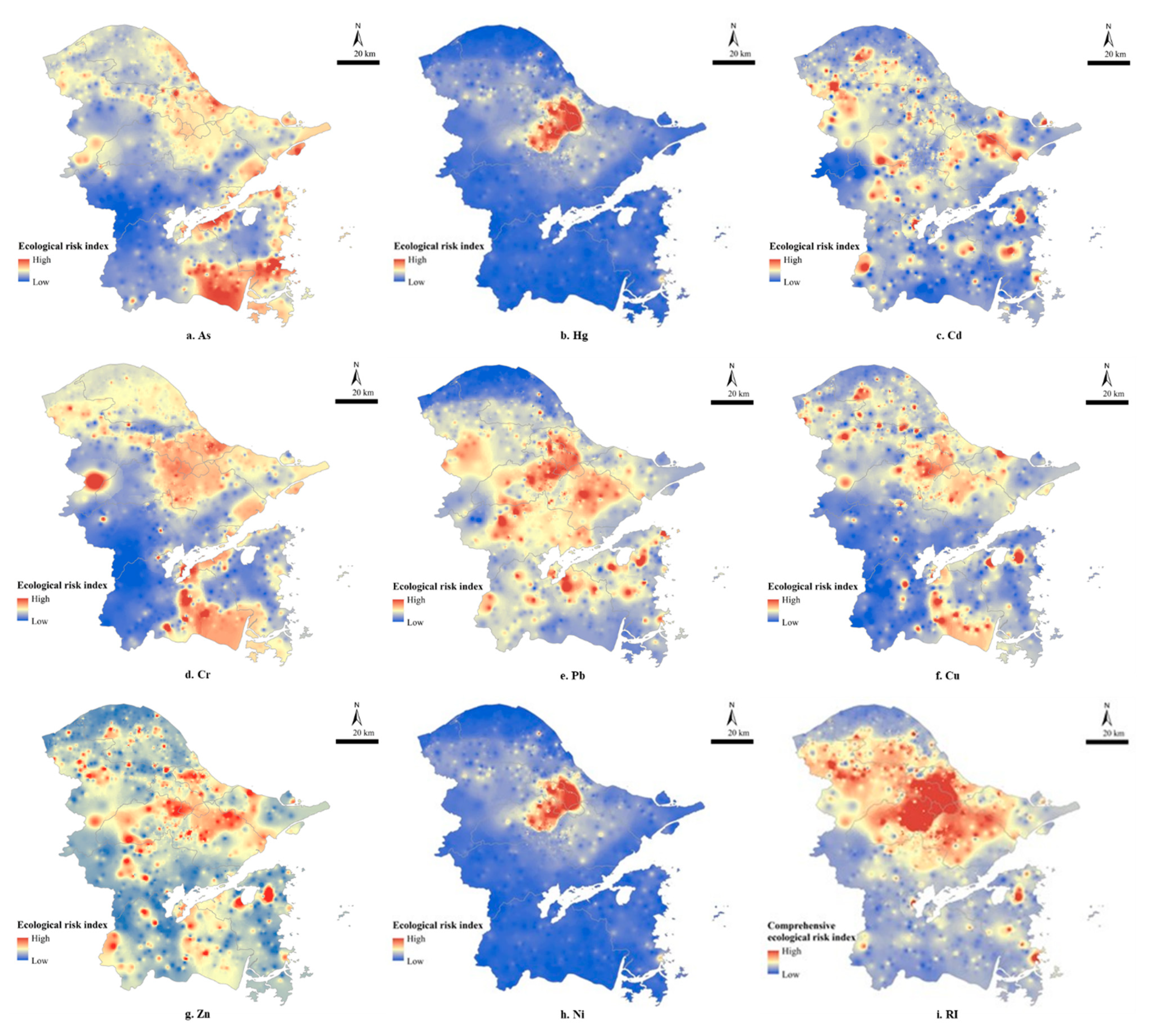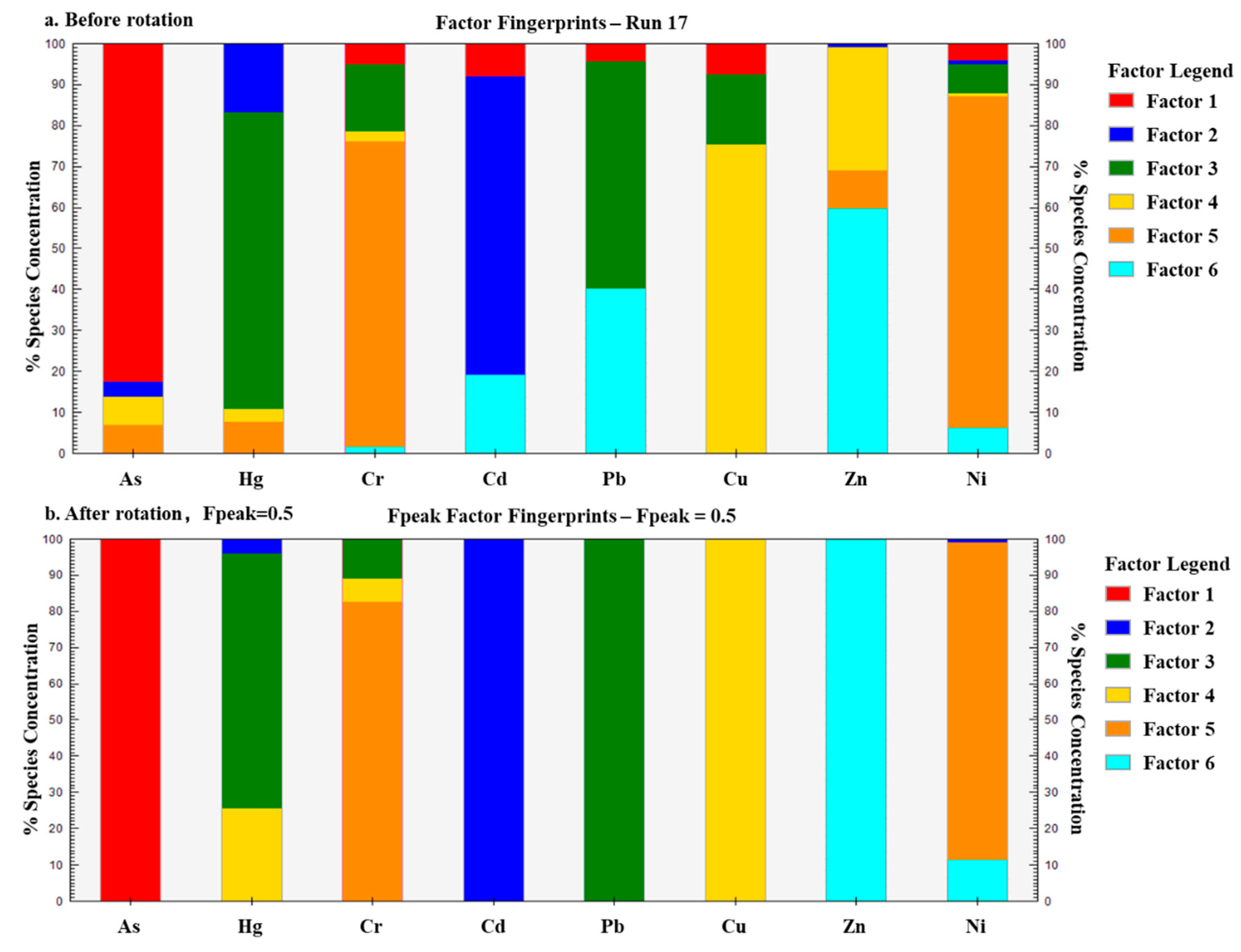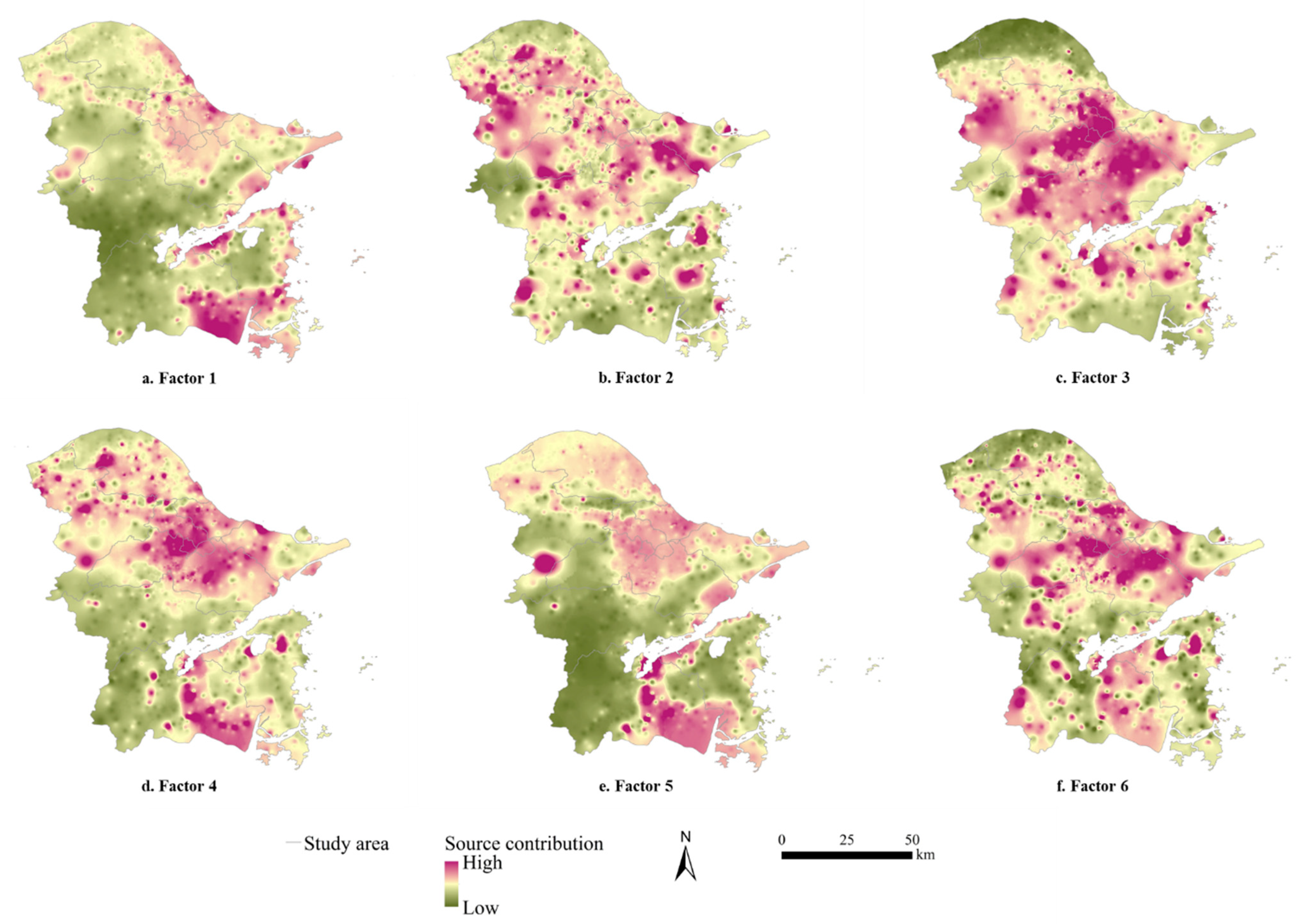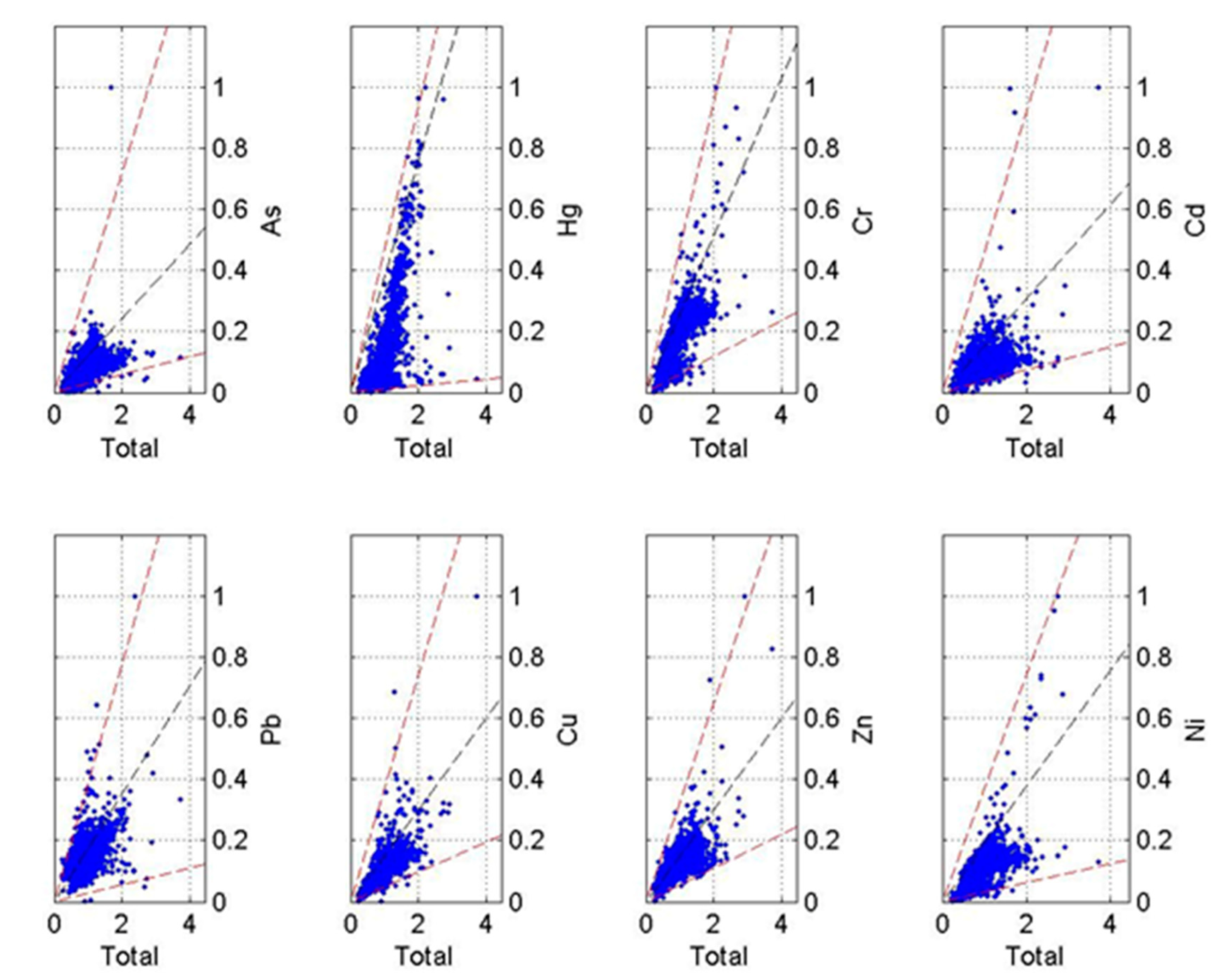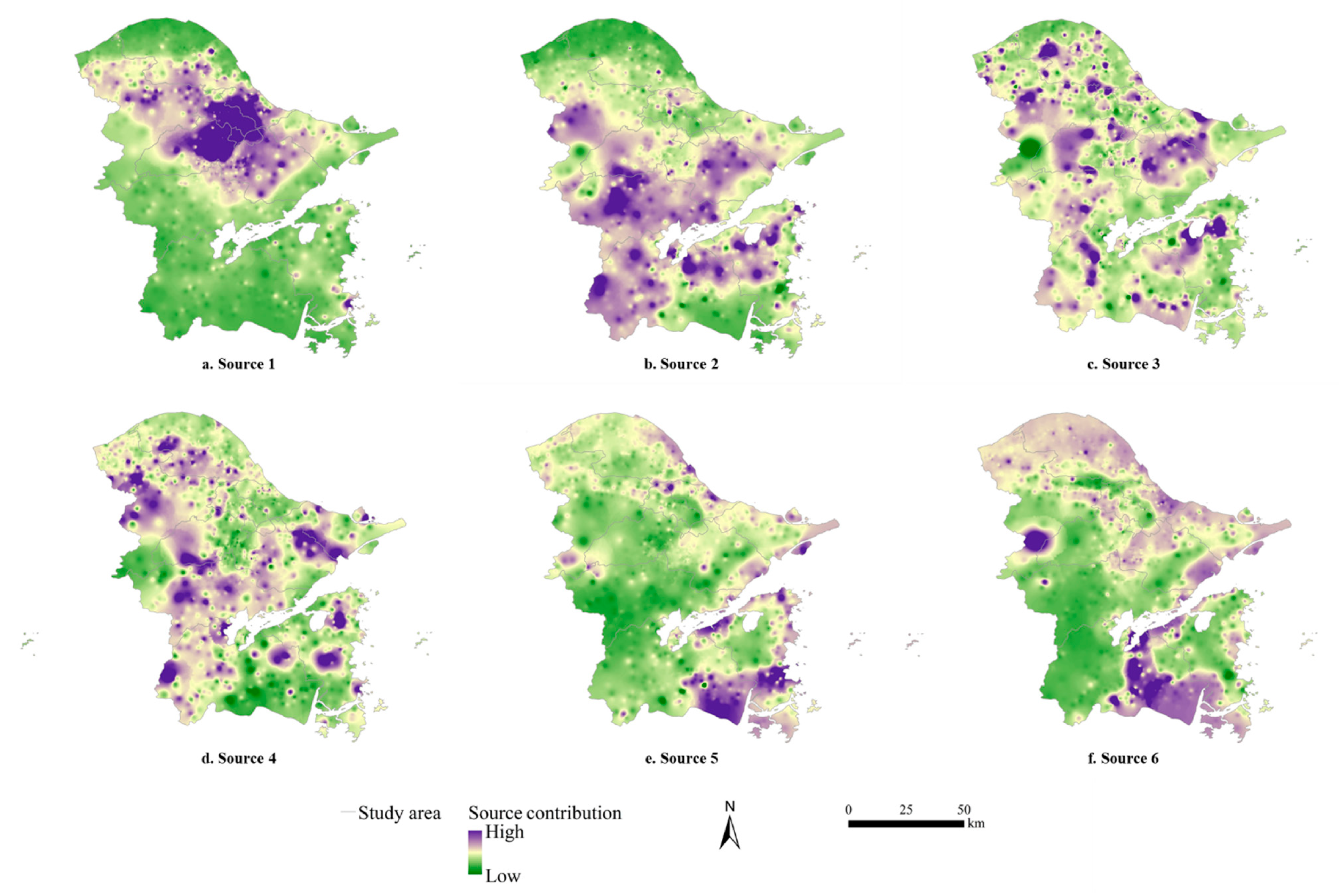3.3.1. Source Apportionment Based on PMF Model
To set the number of factors as 3–9 and the operation times as 20, the initial points were randomly selected to run the PMF model successively [
39]. When the number of factors was 6, the ratio of Q
robust to Q
true tended to converge and reached the minimum, and the residual error ranged from −3 to 3. Moreover, the r
2 values of the most potential toxic elements were larger than 0.88, except that the r
2 value of Hg was 0.4. Consequently, the six factors were able to fully explain the information contained in the original data, indicating that the six-factor source scheme was the most stable based on the PMF model (
Figure 4).
Based on the PMF model, six factor components and corresponding contributions of potential toxic elements were identified (
Table 4). Since the load of Factor 1 only had As, Factor 1 was obviously the main source of As. Although Cd, Hg and Ni all had loads in Factor 2, whereas the load of Cd reached up to 100%, Factor 2 was the main source of Cd. Hg, Cr and Pb all had loads in Factor 3. Since the loads of both Hg and Pb were far higher than the load of Cr (the load of Pb even reached up to 100%), Factor 3 was taken as the main source of Hg and Pb. As for Factor 4, the load of Cu reached up to 100%, which was much higher than the loads of both Hg and Cr, and it could be considered as the main source of Cu. Factor 5 had similar loads of Cr and Ni, i.e., 82.750% and 87.644%, respectively, which was the main source of Cr and Ni. Since Factor 6 had distinct loads of Zn (100%) and Ni (11.415%), it was evidently the main source of Zn.
The highest load of Factor 1 is As. Up to 99.95% of the samples are not contaminated by As (
Table 3), indicating little interference of human activity. Soil parent material is the main source of As background in soil, and the content of As will gradually enrich with later development of the soil. Generally, the concentration of As is less than 15 mg/kg, whereas there were 6 samples in the study region whose concentrations of As exceeded 15 mg/kg. These samples were distributed in coastal cultivated lands from the east to the south (
Figure 5a), suggesting a connection with inappropriate agricultural inputs (e.g., fertilizers and pesticides) [
40,
41]. Therefore, Factor 1 was a composite source of nature and agriculture.
Cd showed a high load in Factor 2. Since Cd was largely affected by external pollution, and the areas of high source contribution were mostly adjacent to the main roads (
Figure 5b), Cd pollution in the study region was related to traffic emissions. Automobile exhaust can accumulate Cd in soil through atmospheric deposition and air dust adsorption [
42]. Furthermore, Cd hiding in automobile tires and fuels can enter the soil through the wear and tear of automobile tires [
43]. Therefore, Factor 2 was a single source of traffic emissions.
Factor 3 was principally composed of Hg and Pb, both of which concentratedly polluted the central urban region. It is obvious that Hg reached extreme variation (
Table 1), and Hg and Pb had homology (
Table 4). In the study region, the majority of industrial enterprises gathered in the central and north (
Figure 5c). Since metallurgy, energy and chemical industries take coals as the primary fuel, the production process makes great contributions to the accumulation and enrichment of Hg. Hence, coal mining and combustion are regarded as the main source of Hg pollution in soil. The potential toxic element Hg is dispersed to the atmosphere during combustion and then enters the soil through atmospheric deposition [
40]. Likewise, Pb accumulation is also largely caused by emissions of coal combustion, and gasoline combustion and wear of automobile parts can increase the concentration of Pb in soil [
44,
45]. Therefore, Factor 3 was a composite source of industrial discharge and traffic emissions.
The load of Factor 4 was mainly Cu. The large areas with Cu pollution had a dispersed distribution. Since the samples in this study were mostly collected from agricultural soil, unreasonable agricultural inputs might be the reason for Factor 4. As an industrially developed city, the deepening of urbanization drove more rural lands into urban construction lands, leaving limited cultivated lands to produce more crops, which aggravates the burden of cultivated lands and leads to excessive fertilizer application. The use of compound fertilizers also causes excessive accumulation of potential toxic elements (e.g., Cu and Zn) in soil [
46]. The high source contribution of Factor 4 was aggregated in the northern part of the study region (
Figure 5d), where the waste gas released by mechanical and electronic enterprises increases Cu pollution in soil through atmospheric deposition. Therefore, Factor 4 was a single source of agriculture.
Factor 5 was primarily composed of Cr and Ni. There was a significant positive correlation between Cr and Ni, indicating that they were polluted by the same sources (
Table 3). Both Cr pollution and Ni pollution in the study region were quite slight, thus they were mainly affected by soil parent material. Since polluted Cr and Ni samples were mainly concentrated in the southern part, where a certain number of textile enterprises are distributed (
Figure 5e), the waste gas settlement caused by industrial activities causes Cr accumulation [
47]. Therefore, Factor 5 was a composite source of nature and industry.
The main load of Factor 6 was Zn, whose pollution did not happen in most areas. Thus, soil parent material and natural weathering processes might partly explain Factor 6. In addition, the collected soil samples were mainly distributed around roads and mechatronics enterprises. The exhausts of automobiles and electroplate factories inevitably lead to the enrichment of Zn [
48]. Therefore, Factor 6 was a composite source of nature, industrial discharge and traffic emissions.
3.3.2. Source Apportionment Based on Unmix Model
The normalization of original data was processed to eliminate the influence of the content difference among eight potential toxic elements. Since the boundary (i.e., red virtual line) appeared in all data boxes of eight potential toxic elements (
Figure 6), rational boundaries were considered to exist among all eight potential toxic elements. Thus, no data needed to be removed and all of them could be used in the Unmix model. When the number of sources was set to six, the Min Rsp was 0.97 and the Min Sig/Noise was 2.77 (
Table 5), both of which were greater than system requirements (i.e., Min Rsq > 0.8 and Min Sig/Noise > 2). Consequently, the result that 97% of the variance of species could be explained was stable and optimal, indicating the six-source scheme was the most reliable based on the Unmix model.
Based on the Unmix model, six source concentrations of potential toxic elements after normalization were identified (
Table 5). All kinds of potential toxic elements have loads in Source 1, especially Hg, Cr and Pb. The contribution of Source 1 to Hg was the largest (peaking at 94%), which was far higher than Cr (23%) and Pb (28%). Hence, the characteristic element of Source 1 is Hg. Pb and Zn had relatively higher loads in Source 2, whose contributions were 47% and 21%, respectively. Whereas for Zn, the contribution of Source 6 was higher than that of Source 2. Hence, the characteristic element of Source 2 is Pb. Source 3 had relatively higher loads of Cu and Zn. The contribution of Source 3 to Cu is 29%, which was lower than that of Source 6 (39%). The contribution of Source 3 to Zn is 18%, which was lower than that of Source 6 (29%) and Source 2 (21%). Hence, the characteristic elements of Source 3 were considered to be Cu and Zn. The load of Cd in Source 4 was much higher than that of other potential toxic elements, and the contribution of Source 4 to Cd was the largest, reaching up to 56%. Hence, Cd was mainly affected by Source 5. In addition to Hg and Cd, all other potential toxic elements had certain loads in Source 5. The contribution of Source 5 to As was 52%, which obviously exceeded that of Source 1 (20%) and Source 6 (22%). Hence, the characteristic element of Source 5 was As. Similar to Source 1, all eight potential toxic elements had loads in Source 6, particularly Cr and Ni. The contributions of Source 6 to Cr and Ni were 61% and 76%, respectively, which were the highest among all sources. Hence, Source 6 was regarded as the main source of Cr and Ni.
Source 1 had a predominate load of Hg. The high-source contribution area of Source 1 was distributed in contiguous urban areas, and scattered across northern and southern sides and the southeast coastal dot area (
Figure 7a). Source 1 was mainly affected by industrial discharge (wastewaters, exhaust gas and waste residue) caused by enterprises or factories, which was similar to the results based on the PMF model. Conversely, the contribution of Source 1 to Pb was lower, based on the UNMIX model, making the component of Source 1 simpler. Therefore, Source 1 was a single source of industrial discharge.
Source 2 was characterized by high loadings of Pb. The CV of the measured concentrations of Pb was 37.22%, suggesting limited human disturbance. The source contributions in the southwest of the study region was higher than that in the eastern coastal area (
Figure 7b), which was similar to the spatial distribution of soil pH, namely higher soil pH in the coastal area but continuously reduced soil pH in the western area close to inlands. Pb in acidic soils dissolves continuously with the increasing of soil acidity [
49], indicating that lower soil pH contributes to higher Pb content in soil. Therefore, Source 2 was a single source of nature affected by soil pH and soil formation process.
Source 3 was heavily loaded with Cu and Zn. There were many dot areas with high source contributions in the study region especially the northern part (
Figure 7c). And a significant positive correlation also showed between Cu and Zn (
Table 2). Electroplate wastewater can bring about excessive Cu and Zn in agricultural soils through irrigation [
50]. The accumulation of Cu and Zn are also closely related to the harmful discharge of mechanical and electronic enterprises in the study region. Therefore, Source 3 was a single source of industrial discharge.
The characteristic element of Source 4 was Cd, whose spatial distribution of source contribution was almost the same as that obtained based on the PMF model. Therefore, Source 4 was still considered as the single source of traffic emissions generated by automobile exhausts and wear of automobile parts.
As accounted for, the highest load was in Source 5. The source contributions of As were higher in coastal areas but lower in inland areas. Therefore, similar to the results based on PMF model, Source 5 was a single source of nature affected mainly by soil parent material.
The characteristic elements of Source 6 were Cr and Ni, and were consistent with Factor 5 based on the PMF model. Therefore, Source 6 was a composite source consisting of soil parent material derived from nature and industrial discharge caused by human activities.
